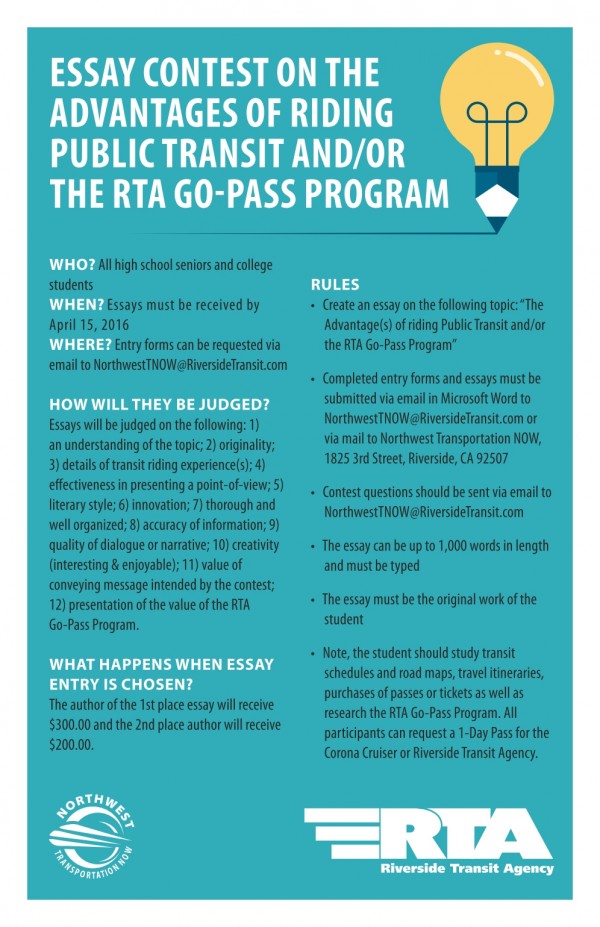
Author Archives: admin
Only 258 apartments plus more shops and services
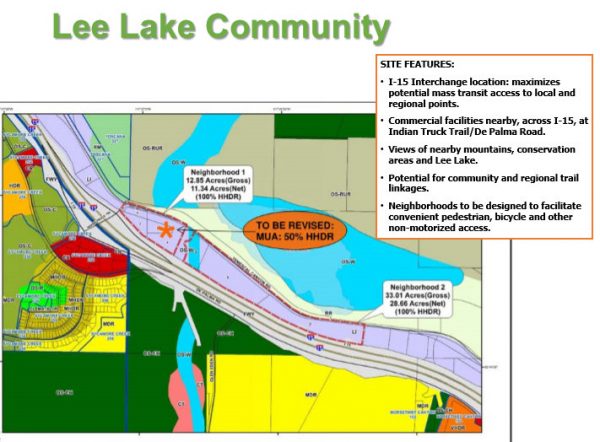
CHANGES MADE: The Planning Commission will recommend to the Board of Supervisors to remove Neighborhood 1 (Lee Lake North) from the project and to change the zoning on Neighborhood 2 (Lee Lake South) to a Mixed Use Area (MUA), allowing for commercial retail and services with only 30 percent of the neighborhood slated for apartments.
Following a lengthy Oct. 5 county Planning Commission public hearing, the five commissioners voted to recommend to the Board of Supervisors to place only 258 apartments in Temescal Valley instead of the 1,200 that were proposed.
Led by District 1 Commissioner Charissa Leach, who also is the commission’s chairwoman, the recommendation is to remove the smaller Lee Lake North neighborhood from the project that was planned for 340 apartments, and change the proposed zoning on the larger Lee Lake South neighborhood to MUA (mixed use area), with only 258 apartments instead of the 860 that were proposed. (See the story below for background information on the projects.)
The MUA zoning calls for commercial retail uses with a predetermined percentage of the total acreage devoted to HHDR (highest density residential) zoning. Throughout the county where MUAs have been proposed, the HHDR percentage has been set at 50 percent. The Lee Lake South neighborhood will be only 30 percent HHDR.
The decision was made after the commission received 212 comments from Temescal Valley residents largely citing the lack of infrastructure to support 1,200 apartments. Additionally, 18 Temescal Valley residents attended the hearing to voice their comments in person. A representative of the owner of the Lee Lake North property also spoke in opposition to the new zoning.
After the public hearing was closed, commissioners discussed the issue and Leach said she agreed with residents’ concerns about inadequate infrastructure. She asked Deputy Planning Director Kristi Lovelady if possibly there was another location where the HHDR zoning proposed for Temescal Valley could be placed. It was determined that the Good Hope unincorporated community, also in county District 1, would be a more suitable location for additional dwelling units than Temescal Valley.
With the Planning Commission’s recommendations, it was noted that the final decision to be made on the Housing Element’s General Plan Amendment 1122 will be by the Board of Supervisors possibly at its Dec. 6 meeting.
People from Temescal Valley who spoke at the hearing were Larissa Adrian, Carol Martinez, Pamela Giandalia, Lisa Welter, Chiku Patel, Gemma Carpio and David Cook – all from Sycamore Creek; Terry Morairty and Brien Clingman – Weirick Road neighborhood; Tracy Davis and Jannlee Watson – Wildrose Ranch; Kelli Noss – Horsethief Canyon Ranch, and Michael Brazeau – Montecito Ranch. Attending but not speaking were Penny and Greg Tucker – Sycamore Creek; Aime Kinne – Dawson Canyon; Roberta Tandy – Trilogy, and John Watson, Wildrose Ranch.
Glen Nelson, Wildrose Ranch resident, authored the We Are Temescal Valley comments sent to the Planning Commission on behalf of the group and signed by Jerry Sincich, Development Committee chairman and Jannlee Watson, Communications Committee chairwoman. That three-page correspondence can be read HERE.
___________________________________________________________________________________________________
(Published Sept. 25, 2016)
HOW TO VOICE YOUR OPINION
Send your email now to: Phayvanh Nanthavongdouangsy at pnanthav@rctlma.org
- CLICK HERE for a form letter that can be copied and pasted into an email
EMAILS AND LETTERS SHOULD BE RECEIVED BY TUESDAY, OCT. 4
Or snail-mail comments to:
Phayvanh Nanthavongdouangsy
Att: Planning Department (12th Floor)
Riverside County Administration Center
4080 Lemon Street
Riverside, CA 92501
- CLICK HERE to print a hard copy that can be mailed
NOTE: If you can, please consider attending the Planning Commission public hearing at 9 a.m. on Wednesday, Oct. 5. It is always more effective if comments are made at the public hearing. The meeting will be at the county’s Administrative Center, 4080 Lemon St., Riverside. ___________________________________________________________________________________________________MORE INFORMATION:
- CLICK HERE for the county’s PowerPoint presentation at the Sept. 14 MAC meeting
- CLICK HERE to view the county’s 13-point criteria used in selecting locations
- Read the story below
- Read comments from Temescal Valley resident Kelli Noss below the story
___________________________________________________________________________________________________
(Published Sept. 6, 2016; updated Sept. 25, 2016)
Temescal Valley is one of 23 unincorporated areas tagged for affordable housing as county updates its General Plan
Temescal Valley might be getting a zone change that would allow construction of 1,200 affordable apartments.
Riverside County is updating its General Plan Housing Element to rezone areas throughout the unincorporated communities to accommodate the state’s mandate for more affordable housing.
For this Housing Element cycle, an estimated 23,794 dwelling units are needed for people in the “Extremely Low and Very Low” and “Low” income categories, including entry-level job seekers, seniors and veterans.
The proposed Temescal Valley area is on the east side of the I-15, immediately south of Indian Truck Trail, west of Temescal Canyon Road and across from Lee Lake. The parcels within the area total about 40 net acres.
To answer the state mandate, the county is creating two new land-use designations – HHDR (highest density residential, R-7 zoning), and MUA (mixed use area, MU zoning).
HHDR would allow between 20 to 40 dwelling units per acre, but the county is using a default density of 30 dwelling units per acre. The R-7 zoning would allow structures taller than three stories, but not to exceed 75 feet in height.
The rezoned areas throughout the county are being referred to as “neighborhoods.” The 40 acres in Temescal Valley have been divided into two neighborhoods which have been labeled “Lee Lake North” and “Lee Lake South.”
While neighborhoods designated HHDR are geared to residential use with amenities such as parks, pathways and recreational facilities, MUAs allow the HHDR use to be combined with a wide-ranging mix of commercial and job-producing services. The proposed land use within Temescal Valley is solely HHDR.
(NOTE: Since the Aug. 3 public hearing when the affordable housing plan was presented to the county Planning Commission, the Lee Lake North community is now being recommended by county staff as a MUA development. The 12.85 gross acres would call for a multi-storied development with the housing built above the commercial shops and services constructed on the ground floor. The 33 gross acres in the Lee Lake South community will remain 100 percent HHDR.)
The neighborhoods are within the Lake Elsinore Unified School District and students would attend Luiseno and Temescal Canyon High schools.
In choosing the affordable housing locations, the county identified sites located in 10 area plans which include 23 unincorporated communities. The county devised a 13-point support factor criteria within each community for the locations of the neighborhoods.
The key to the criteria was the “walkability” factor. The county has defined “walkable” as “A continuous network of sidewalks, paths, and street crossings that encourages pedestrian travel between origins and destinations free of obstructions and in a safe and comfortable environment.”
The proximity factors considered were jobs, retail commercial, schools, community centers, child care centers, places of worship, and hospitals, medical centers and clinics. Other factors were proximity to bicycle trails, parks and recreation, pedestrian paths and trails, freeway interchanges, bus transit and commuter rail stations.
The county recognizes that no site is ideal based on all the support factors. According the proposed Housing Element, “Some sites with only a few ideal characteristics available have been included, due to limited site availability options in some communities.”
The affordable housing plan was presented to the county Planning Commission at an Aug. 3 public hearing. The issue was continued to the Wednesday, Oct. 5 meeting to give staff the opportunity to respond to questions asked by commissioners. Public comments also will continue to be heard at the Oct. 5 meeting.
It is expected that the Planning Commission will finalize its review at the October meeting and vote to recommend that the Board of Supervisors approve the Housing Element and land-use designations, plus the associated environmental impact reports. Another public hearing will be held prior to the supervisors’ approval.
Sample comment to copy and paste into email
Phayvanh Nanthavongdouangsy
Att: Planning Department (12th Floor)
Riverside County Administration Center
4080 Lemon Street
Riverside, CA 92501
Re: Proposed General Plan Amendment No. 1122, Change of Zone No. 7902 and Ordinance No. 348.4840
Dear Ms. Nanthavongdouangsy
I am writing to you in regards to the Elsinore Area Plan – Lee Lake Community Proposed General Plan Amendment No. 1122, Change of Zone No. 7902 and Ordinance No. 348.4840.
The highest density residential (HHDR) land-use designation in the Elsinore Area Plan – Lee Lake Community will adversely impact current Temescal Valley residents as well as future residents of the proposed housing developments.
- The Walk Score and Transit Score at this location are both under 10 on a scale of 0 to 100. These extremely poor scores would require the new residents (seniors, veterans, disabled, etc.), to be “car-dependent.”
- The already gridlocked Interstate 15 freeway and Temescal Canyon Road at this location would further impede the new residents from traveling to and from work or accessing necessary services and amenities. Currently, there is no timeline for expansion of the I-15 and improvements to Temescal Canyon Road.
- Temescal Valley lacks jobs. The proposed location would not provide sufficient jobs within walking distance for the large majority of the new residents.
- The new residents would need vehicles to transport their children to and from schools in the Lake Elsinore Unified School District. This would create more gridlock on the primary (I-15) and secondary (Temescal Canyon Road) transportation corridors. Currently, Sycamore Creek residents living adjacent to this proposed development can spend up to 45 minutes to one hour each way in transporting their children to the nearest high school 9 miles away.
- This location has: 1) no child care centers within 1 mile; 2) no churches within 1 mile; and 3) hospitals, medical care centers and clinics greatly exceed 5 miles in distance. There is no public community center in Temescal Valley and no RTA fixed-route bus service. Because there is no bus service, Dial-A-Ride is unavailable to Temescal Valley residents. Currently, there is no timeline for the future development of these amenities and services.
- Upon approval of General Plan Amendment No. 1122, landowners would be able to fast track and complete a development that would place more than 1,000 dwelling units in an area with limited amenities, services and “walkability.”
Until the infrastructure, amenities and services are in place, I urge the Riverside County Planning Commission to carefully review and identify a more suitable location for the highest density residential (HHDR) land-use designation and remove the Lee Lake Communities from the proposed General Plan Amendment No. 1122.
Sincerely,
School safety tips
Milkweed to Monarch project? Learn all about it here
 By Tracy Davis
By Tracy Davis
Identity Committee Chairwoman
Why the monarch? We see butterflies everywhere.
The plight of the monarch butterflies was brought up at our Identity and Beautification meetings in November 2015, inspired by articles appearing in the Orange County Register and The Press-Enterprise the week before.

Monarch caterpillars chomp away on native milkweed.
Milkweed is the preferred plant of monarch caterpillars which hatch from eggs laid on the milkweed plants by mama monarchs. One of the reasons the monarchs are in decline is because native milkweed is becoming harder for them to find.
The 90 percent decline in the monarch population for the last 10 years was all we needed to know to start our project. Pulling both committees into the solution, I took the lead because of my love and fascination for insects, knowing full well it would be a huge project.
PARTNERSHIPS ARE FORMED
A month later, lo and behold my friend Nancy Reiter, who is Branch Manager at El Cerrito Public Library, had seen the same article and was looking into a Books2Action grant for books on the monarch subject. She contacted me to see if the We Are Temescal Valley group would sign off as a partner in the project, helping secure the grant. We got together for a committee planning session and worked with the Temescal Heritage Foundation to secure the grant as partners.
This set the ball rolling to include the Sycamore Creek Interpretive Center — a Riverside-Corona Resource Conservation District (RCRCD) nature center located in the heart of Sycamore Creek. They, too, were planning a conservation project for native milkweed.
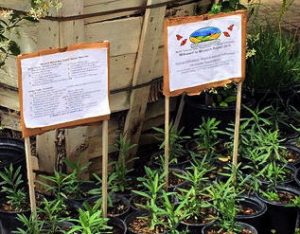
7 Oaks Nursery and The Acorn Cap, both located in Temescal Valley, sell native milkweed.
Now came our dilemma — no known local nurseries grew the native milkweed or had sources. We needed to convince our local 7 Oaks Nursery to grow the native milkweed for the project. Bringing all the facts and known sources for seeds to 7 Oaks, it took about a month to convince them it was good for the nursery and the monarchs.
In checking the seed sources, a native nursery popped up — The Acorn Cap, a nursery that specialized in California natives. It was located in Horsethief Canyon Ranch but had not yet changed its postal designation to Temescal Valley. By the end of January, we had not one but two local nurseries growing milkweed for us and the caterpillars!
Educating the people of Temescal Valley would take time. We began with the homeowners’ associations. I attended nearly all of the HOA board meetings in Temescal Valley to share the need to use native milkweed rather than other variations to bring back the monarch.
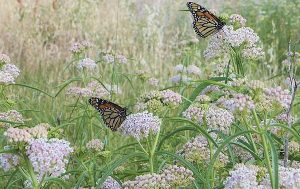
GOOD MILKWEED: Monarchs are drawn to this native milkweed — Asclepias fascicularis, and will lay eggs on it. The caterpillars that hatch will eat the milkweed, stripping it bare and leaving nothing but sticks. It goes dormant but grows back each year.
WHY NATIVE MILKWEED IS IMPORTANT
Native milkweed dies back in the winter forcing the monarchs to migrate but tropical milkweed (Asclepias Curassavica), grows year-round in our mild climate. Monarchs will not migrate where tropical milkweed is planted because it provides a winter food source for the caterpillars. Winter breeding is unwanted in our area because it exposes the butterflies to the OE (Ophryocystis elektroscirrha), parasite. This parasite either kills or weakens the caterpillars and adults, making their migration north each spring an impossible challenge in unhealthy monarchs. Planting native milkweed encourages proper seasonal migration and reduces the incidence of parasitic exposure. (Native versus Tropical? Learn more HERE)
Bottom line is that the monarchs’ milkweed habitat is dramatically reduced due to human population increases, and pesticide and herbicide use in farming and along roadsides.
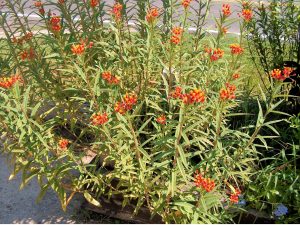
BAD MILKWEED: Tropical milkweed stays green year-round and has colorful flowers — usually red, orange and yellow. Because milkweed caterpillars can constantly feed on it, the monarchs will not migrate which leaves them exposed to a parasite.
In researching the monarchs, I found that many sites have been logging habitat, migration and population of the butterflies. Monarch Watch stands out as a good resource for plants around the nation, but the Xerces Society lists the natives best for our area, also giving us a guide to create the proper habitat for the monarch and other pollinators. (Click HERE for milkweed list.)
HOAs and residents can add to their gardens to create more habitat for the monarchs easily with our local nurseries growing native narrowleaf milkweed (Asclepias fascicularis), for the project.
We also need nectar sources to feed the adults. The nectar list is long, but look for flowers that monarchs can rest on while sipping, including composite heads, like sunflower, daisy or aster types, or clusters of flowers like lantana, verbena and pentas. Nectar sources do not have to be native, but choose drought-tolerant for our area. (Click HERE for native pollinator list.)
We hope that as more and more Temescal Valley folks decide to plant native milkweed and nectar plants to entice monarchs to their gardens that they will pay the $16 necessary to register their habitat with the Monarch Waystation Program. The Waystation registry could get our project national attention — so if you decide to register your habitat, please be sure to use Temescal Valley as your address! (Click HERE for the registration form.)
TEMESCAL VALLEY GETS INVOLVED
In trying to get the word out about the Milkweed to Monarch project we integrated Monarchs as a theme into our local events. The We Are Temescal Valley Identity Committee hosted the Temescal Valley Scavenger Hunt which had a monarch theme. The HOAs were encouraged to participate at the 15 stations around the valley. The main prize was a narrowleaf milkweed, with many other prizes donated by our local businesses.
Horsethief Canyon Ranch also had a Native Plant Sale. Hosted by Bob Hafner, chairman of the Beautification Committee and The Acorn Cap, the sale encouraged residents of the valley to plant native milkweed. The Temescal Valley Community Faire also adopted the theme of Monarchs and Melons for the 16th annual event held in May.
Our Milkweed to Monarch project is growing. We’re encouraged by our partnership with community nurseries and collaboration with educational organizations. Our success will make Temescal Valley the “Home of the Monarch!”
GET THE KIDS INVOLVED!
Here are links to help children better understand how truly incredible the monarch butterfly is — fun facts and things to do:
Journey North for Kids
Raising Monarch Butterflies
Make Felt Monarch Butterfly Wings
A Magical Metamorphosis
Thank you for your participation in this project and thanks also to:
![]() 7 OAKS NURSERY, 21501 Temescal Canyon Road, Temescal Valley, 951-277-2927. Open 8 a.m.-5 p.m., seven days a week. On Facebook
7 OAKS NURSERY, 21501 Temescal Canyon Road, Temescal Valley, 951-277-2927. Open 8 a.m.-5 p.m., seven days a week. On Facebook
 THE ACORN CAP, California Native Nursery, Temescal Valley, 951-245-4764. On Facebook
THE ACORN CAP, California Native Nursery, Temescal Valley, 951-245-4764. On Facebook
 EL CERRITO PUBLIC LIBRARY, 7581 Rudell Road, Corona, 951- 270-5012. Open 3-7 p.m., Monday-Thursday; 10 a.m.-2 p.m. Saturday. On Facebook
EL CERRITO PUBLIC LIBRARY, 7581 Rudell Road, Corona, 951- 270-5012. Open 3-7 p.m., Monday-Thursday; 10 a.m.-2 p.m. Saturday. On Facebook
 SYCAMORE CREEK INTERPRETIVE CENTER (RCRCD), 11875 Indian Truck Trail, Temescal Valley, 951-515-2097. 10 a.m.-2 p.m., Monday-Wednesday. On Facebook
SYCAMORE CREEK INTERPRETIVE CENTER (RCRCD), 11875 Indian Truck Trail, Temescal Valley, 951-515-2097. 10 a.m.-2 p.m., Monday-Wednesday. On Facebook
Fate of Alberhill Villages could be decided by voters
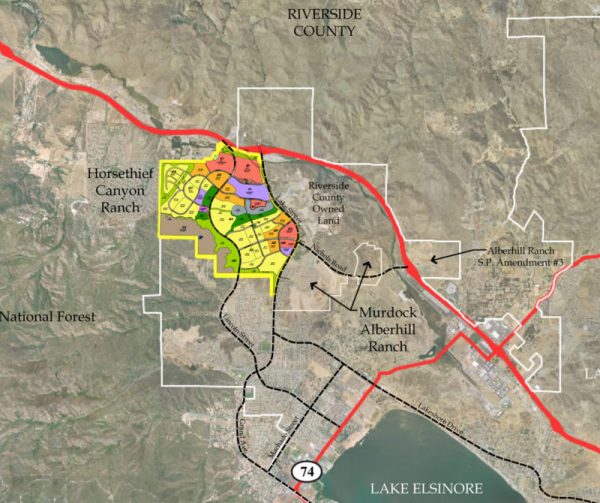
ALBERHILL VILLAGES: The Lake Elsinore City Council approved the Alberhill Villages Specific Plan at its June 14 meeting. Developer Castle & Cooke has said it will pursue placing the project on the ballot for voter approval.
(Published July 8, 2016)
Lake Elsinore resident Dana Mark Coon has received approval to begin the initiative process in an attempt to have the massive Alberhill Villages project placed on the November ballot,
The 8,244-home Alberhill Villages Specific Plan, approved by the City Council in June, had several city-imposed conditions that developer Castle & Cooke opposes and would prefer that the project’s future be decided by city voters.
Coon in March had approached the city seeking the necessary paperwork to begin the signature-gathering process to place the initiative on the ballot. After reviewing the 263-page initiative, Coon’s request was denied by City Attorney Barbara Liebold.
Coon approached the city again on June 10, submitting a revised initiative that addressed the concerns of constitutionality raised earlier by Liebold.
Liebold on June 27 issued the necessary paperwork that allows Coon to begin gathering signatures in an attempt to qualify the initiative for the November ballot.
If the required number of signatures is obtained and voters approve the project, Liebold has said the vote would probably supersede the city’s approval.
RELATED PRESS-ENTERPRISE REPORT:
June 28, 2016: Alberhill supporters cleared to gather signatures
Mega project OK’d with mega conditions
(Published June 15, 2016)
The Lake Elsinore City Council, against the wishes of developer Castle & Cooke, has approved the 8,244-home Alberhill Villages Specific Plan.
Castle & Cooke attorney Stephen Miles told City Council members, “This is not the developer’s specific plan. This is the city’s specific plan,” referring to the city-imposed conditions placed on the plan after it was presented to the city’s Planning Commission in February.
Since then, Castle & Cooke is seeking an initiative that would allow voter approval of the project, circumventing the city conditions which the developer has said would make the plan “unbuildable.” (Read more about the initiative below.)
The main areas of disagreement include:
- The almost 46-acre, multi-million-dollar sports park – The developer will give the city the land but wants the city to construct it; the city wants the developer to build it.
- Mining setbacks – Current M-3 (mining), zoning on the property allows for homes to be built 300 feet from mining operations. The city changed it to 1,000 feet and at the meeting changed it again to 1,500 feet.
- M-3 zoning – Because of this zoning, if the developer wasn’t able to entice the retail/commercial businesses nor the hospital or university to the development, the M-3 zoning would allow for heavy industrial uses.
- Traffic studies – A traffic impact analysis will be required for each of the phases as they are developed. Six phases are anticipated over 30 years. Riverside County submitted a letter supporting this requirement because of possible impact to Temescal Valley along Temescal Canyon Road. The county requested that the traffic studies include all of Temescal Canyon Road north to Indian Truck Trail.
- Public safety – The city wants a community facility district (CFD), created to cover the cost of police and fire services. Alberhill Villages home and property owners would pay the tax annually on their property tax bills. The developer maintains that the CFD isn’t necessary because of the several million dollars in sales tax they say will be generated by the project.
Additionally, the city wants the 1,400-acre project reduced to 1,375 acres to create open space buffer areas. The acreage of the wildlife corridor near the Temescal Wash and Temescal Canyon Road would be increased. Also, 220 homes have been removed from the project to provide more open space between Horsethief Canyon Ranch and the Alberhill Villages boundary.
Castle & Cooke can accept the approval of the plan as conditioned by the city or continue its attempt to place an initiative on the ballot for voter approval.
RELATED PRESS-ENTERPRISE REPORT:
June 15, 2016: Plan for 8,000-home project wins council nod, despite developer’s objections
City, developer battle over how project is to be approved
(Published June 10, 2016)
Much has transpired since the Lake Elsinore Planning Commission in February voted to recommend to the City Council the approval of the Alberhill Villages Specific Plan.
In addition to the proposed 8,244 homes, the 1,400-acre project includes plans for a four-year university, medical facilities, a new public school, shopping, dining and entertainment, plus parks, trails and two lakes encompassing about 50 acres. It is estimated that the project will be built in six phases over 30 years, serving as the reclamation process for the Pacific Clay mining operation as it is phased out.
Alberhill Villages would be built adjacent to Horsethief Canyon Ranch between the Temescal Valley border and Lake Street.
Apparently, project developer Castle & Cooke doesn’t agree with the conditions the city has imposed on the project and, instead, wants city voters to decide its fate. After endorsement by the Planning Commission, Castle & Cooke asked the city to take no further action on the Specific Plan and its Environmental Impact Report.
Acting on behalf of Castle & Cooke, Lake Elsinore resident Dana Mark Coon in March approached the city seeking the necessary paperwork to begin the initiative process to launch a petition drive to have the project placed on the November ballot.
After reviewing the 263-page initiative, Coon’s request was denied by City Attorney Barbara Liebold, who then filed a complaint asking a Riverside County judge to stop the initiative process from going forward.
Liebold claims that the proposed Alberhill Villages initiative differs greatly from the Alberhill Villages Specific Plan that was reviewed by the Planning Commission in February. She views the initiative as unconstitutional and that it “unfairly benefits Castle & Cooke and shifts the costs of the proposed development to the Lake Elsinore taxpayers.” Additionally, if voters were to approve the ballot measure, the City Council would have little say on how the project is developed over the next 30 years.
A series of court actions has ensued since the city filed the complaint – lawsuits, appeals, counter lawsuits – with a California Supreme Court ruling on April 28 that denied Coon’s emergency request that the city prepare the necessary paperwork to begin the petition process of gathering signatures to qualify the initiative for a ballot vote.
The initial complaint filed by Liebold to determine the constitutionality of the initiative is yet to be decided, with the next court date scheduled July 27.
In the meantime, the city has ignored the request by Castle & Cooke to take no further action on the Alberhill Villages Specific Plan and scheduled a Tuesday, June 14 City Council public hearing on the project.
This latest action was addressed by Castle & Cooke attorney Stephen Miles in a letter delivered to the city on Friday, June 10. The letter cites unresolved issues that Castle & Cooke says were not addressed in the Specific Plan approved by the Planning Commission, including consideration of the Pacific Clay Development Agreement which was omitted from the plan. Also noted were the conditions added to the plan by city staff that Castle & Cooke finds “onerous.”
The correspondence by Miles concludes that Castle & Cooke and proponent Coon “remain fully committed to seeking voter support for Alberhill Villages.” The letter also “demands” that the city remove the project from the June 14 agenda or reschedule it for the July 26 City Council meeting.
Coon also approached the city again on June 10 re-seeking the necessary paperwork to begin the initiative petition process to put the project on the ballot and submitted a revised initiative that addresses the concerns of constitutionality raised by City Attorney Liebold.
As of June 12, the project remains on the City Council agenda for June 14. If the Alberhill Villages Specific Plan is approved by the council and Castle & Cooke is successful in the initiative process and Lake Elsinore voters approve the project, Liebold has said the vote would probably supersede the city’s approval.
RELATED PRESS-ENTERPRISE REPORTS:
March 9, 2016: Petition seeks vote on Alberhill Villages proposal
April 1, 2016: City sues to block petition
April 15, 2016: Judge says initiative petition can proceed
April 19, 2016: City appeals to stop Alberhill Villages petition
April 29, 2016: Justices deny initiative backers’ plea
June 8, 2016: Massive development plan gets hearing
June 10, 2016: New initiative filed on huge project
CITY PRESS RELEASES:
April 22, 2016: Why the city attorney challenged the Alberhill villages initiative
April 28, 2016: Supreme Court denies request by Alberhill Villages Proponent
June 3, 2016: City announces public hearing regarding Alberhill Villages
City planners support Alberhill Villages
(Published Feb. 19, 2016)
The Lake Elsinore Planning Commission voted Feb. 16 to recommend the approval of the 8,244-home Alberhill Villages development to its City Council.
City planners were told the 1,400-acre project, in addition to the homes, will feature a four-year university, medical facilities, a new public school, shopping, dining and entertainment, plus parks, trails and two lakes encompassing about 50 acres. Several Lake Elsinore residents spoke in favor of the project, citing the 5,500 new jobs and several million in sales tax dollars they say it will bring to the city and the increased opportunity to “shop local.”
It is estimated that the project will be built in six phases over 30 years, serving as the reclamation process for the Pacific Clay mining operation as it is phased out.
Twenty-four Temescal Valley residents submitted emailed comments opposing the project because of its location between Lake Street and the city’s boundary adjacent to Horsethief Canyon Ranch. The opposition was based on no foreseeable solutions to ease traffic on the I-15 and the findings of the project’s environmental impact report that states traffic and transportation impacts caused by the project cannot be mitigated to a less than significant level. The 24 emails were entered into the public record and will be given to the City Council.
The project’s plans indicate that Lake Street will be widened to eight lanes at the freeway and Temescal Canyon Road within the city’s boundaries will be widened to six lanes.
Russell Williams, a development review manager with the Riverside County Transportation Department, spoke at the meeting asking that the city and applicant Castle & Cooke work with the county on a road improvement phasing plan that would provide appropriate improvements to Temescal Canyon Road. He said the improvements to Temescal Canyon Road, both within and outside of the project area, would be tied to individual phases of the project as it is constructed.
It was the recommendation of the Planning Commission to pass on the county’s request to the City Council.
The first phase of the project would include 1,300-plus dwelling units, the university – possibly a teaching hospital, retail and commercial, and a sports park. The next step in the approval process will be a public hearing before the Lake Elsinore City Council at a date yet to be determined.
RELATED PRESS-ENTERPRISE REPORT:
Feb. 17, 2016: Massive project wins panel’s support
Public comments due on mega-project
(Published on Feb. 13, 2016)
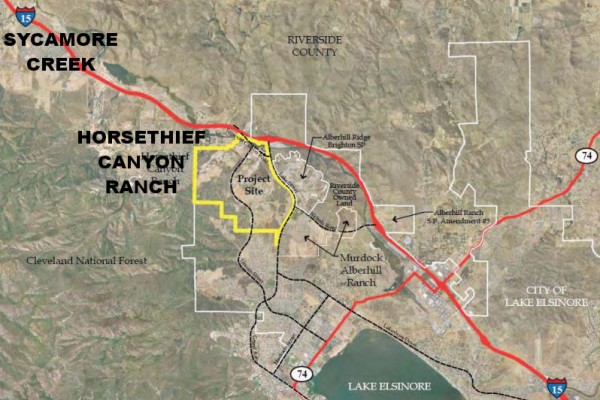
8,244 HOMES: The Lake Elsinore Planning Commission at its Feb. 16 meeting could approve plans for Alberhill Villages, outlined in yellow.
Report finds impacts on traffic and transportation to be unavoidable
Comments either for or against the 1,400-acre Alberhill Villages development are now being accepted by the city of Lake Elsinore prior to a public hearing for the project at the city’s Planning Commission meeting Tuesday, Feb. 16.
The project is located at the city’s northern boundary, north of Lake Street, and will be built just south of Horsethief Canyon Ranch.
Land owner Castle & Cooke wants to build 8,244 homes and devote an additional 4 million square feet to non-residential uses including a 6,000-student university. While many say it will take 20 to 30 years for build out, the project’s specific plan and draft environmental impact report (DEIR), could be approved by the city’s Planning Commission on Feb. 16, and ultimately receive final approval by the City Council.
With no timeline in place for improvements to the 1-15 south of Cajalco Road, Temescal Valley residents have voiced concern about the project’s impact on transportation and traffic.
The environmental impact report found that the development will have significant impacts that cannot be corrected. The DEIR “ … determined that, even with the imposition of all feasible mitigation measures, the project will have significant and unavoidable project-level and cumulative impacts related to Air Quality, Transportation, Traffic, and project-level impacts related to Noise, which cannot be mitigated to below a level of significance.”
Comments should be emailed before Feb. 16 to Roy Stephenson, land use engineer, at rstephenson@hrgreen.com. For those wishing to comment at the public hearing, the meeting is at 6 p.m. at the Lake Elsinore Cultural Center, 183 N. Main St.
MORE INFORMATION:
About the project
Specific Plan, EIR and related documents
RELATED PRESS-ENTERPRISE REPORTS:
Dec. 11, 2015: Developer drops lawsuit against city
Nov. 25, 2015: As planned, new community is largest in city
Dangerous street condition? Where is it?
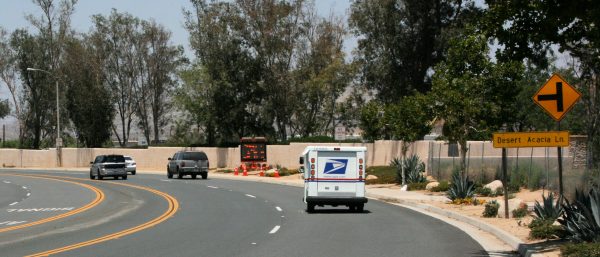
SLOWING DOWN TRAFFIC: County Road Engineer Lawrence Tai had two portable digital radar signs placed on Knabe Road after the Public Safety Committee meeting in May. The signs will be moved to other busy Temescal valley streets in the weeks ahead.
HAVE YOU SEEN DANGEROUS ROAD CONDITIONS such as blind corners, lack of left turn lanes or the need for stop signs? Send what you’ve seen and possible suggestions on how the problem can be fixed to Public Safety Committee Chairman John Watson at: jfwatson5@aol.com. Include the community in which the street is located, the problem, your name and how to reach you if necessary. A list is being compiled and all suggestions will be reviewed by the county.
The We Are Temescal Valley Public Safety Committee meeting in May focused on road safety in two areas – on surface streets and at the three schools located here.
Addressing the schools issue was CHP Community Service Officer Nate Jimerson who, along with other duties, is responsible for enforcing traffic laws at 24 schools within his CHP region. New to the position, Jimerson said he had visited the Todd and Temescal Valley elementary school campuses and hoped to patrol at Luiseno School prior to summer dismissal.
He said while the “dropping off” and “picking up” situations at the schools are less than optimal, parents are not justified in double parking, blocking driveways and parking in red zones. “Offenders will be cited,” Jimerson said.
Committee members commended Jimerson for fighting freeway traffic to attend the evening meeting on his day off.
Also attending the meeting was Renee Martin, a valley resident and the crossing guard at TVES. She said the flagrant violations by parents amaze her and she often worries about student safety. “Some people park in the red zones at both ends of the crosswalk and it’s the same parents doing it repeatedly.”
She said there are parents who will not follow her whistle commands when to cross and not cross the street. “I had the kids waiting to cross to let cars by and one dad grabbed his kid’s hand and said, ‘Let’s go.’ I was so proud of that little boy when he told his father, ‘No Dad, we can’t go until the guard says it’s safe.’ ”
Both Jimerson and Martin felt the best way to reach the parents about street safety was through their children. The Public Safety Committee, working with the CHP, will suggest to school administrators the possibility of street safety assemblies in the new school year.
Riverside County Road Engineer Lawrence Tai spoke about the public roadways in Temescal Valley. Tai said he was familiar with the county-maintained streets and knew of the larger traffic issues, i.e. Temescal Canyon Road, but wasn’t aware of all the individual issues within each of the neighborhoods. “I am aware, though, of concerns about speeding on surface streets.”
He described how speed limits are determined – not a simple process, and what it takes to get a new stop sign or traffic signal – also not a simple process but doable if warranted. What isn’t particularly doable are speed bumps, especially on arterials such as Knabe, Campbell Ranch, De Palma and Horsethief Canyon roads, and Trilogy Parkway.
“Speed bumps are hard on public safety vehicles such as fire engines rushing to emergency calls, as well as on the personnel inside the vehicles,” Tai said.
Several people at the meeting cited specific safety issues on neighborhood streets – blind corners, lack of left turn lanes, the need for stop signs. Tai said the county will investigate all concerns and possible solutions, but folks must let the county know where the problems are.
When asked, Tai said the county could install portable radar speed signs letting motorists know the speed at which they are driving. He said the digital displays are a good deterrent in slowing down speeders. Tai had two signs placed on Knabe Road and they will be moved to other streets where speeding is a problem.
Tai was impressed by the number of HOAs and neighborhoods represented by members of the Public Safety Committee, and said if the group could compile a list of concerns, he would look into all issues raised.
Send suggestions about street safety to Public Safety Committee Chairman John Watson at: jfwatson5@aol.com. Include the community in which the street is located, the problem, your name and how to reach you if necessary.
Committee members discussed launching a petition drive for the state to increase the number of CHP officers along the 1-15 Corridor. The committee also will create a campaign aimed at slowing down motorists on Temescal Valley streets.
If you would like to be notified of upcoming Public Safety Committee meetings, email your request to Watson.
2016 PHOTO CONTEST WINNERS
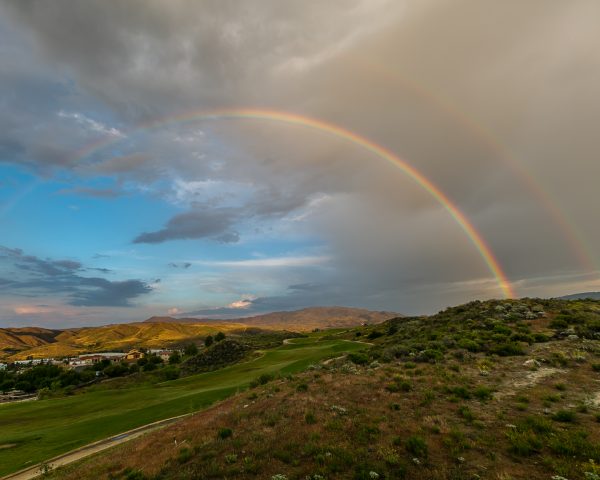 Landscape First Place: “Temescal Valley: At the End of the Rainbow,” by Rob Mucha
Landscape First Place: “Temescal Valley: At the End of the Rainbow,” by Rob Mucha
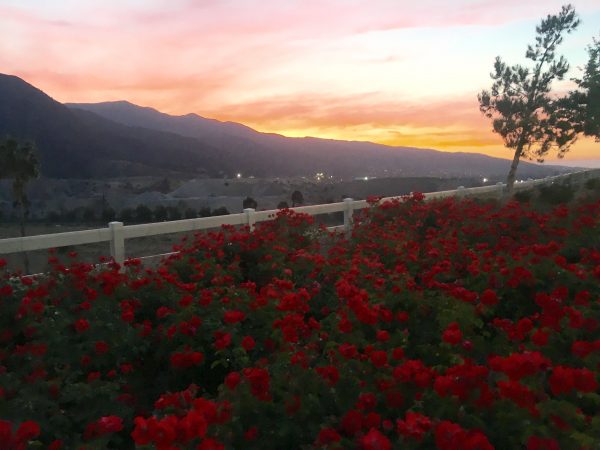 Landscape Second Place: “Deleo Park Sunset,” by Rylee Patton
Landscape Second Place: “Deleo Park Sunset,” by Rylee Patton
Planners give nod to 54 homes
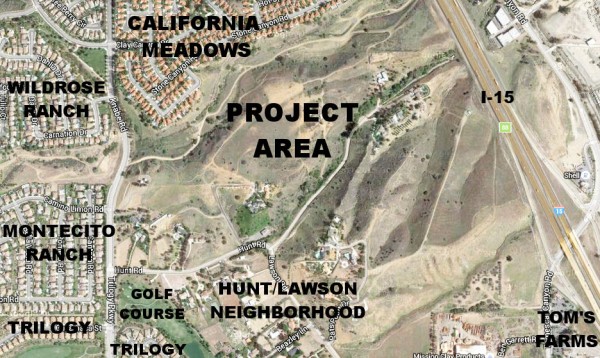
54 HOMES PLANNED: The applicant for a housing development that was approved by the county in 2009 has had to make revisions to the original plan.
VIEW COUNTY STAFF REPORT AND ENVIRONMENTAL ASSESSMENT
UPDATE: April 20, 2017
The Riverside County Planning Commission, following an April 19 public hearing, voted to recommend to the Board of Supervisors the approval of a 54-home development in the Hunt/Lawson neighborhood.
According to Project Planner Russell Brady, seven letters of opposition and a petition with more than 130 signatures were received prior to the hearing. Five Temescal Valley residents spoke at the hearing, citing unsafe road conditions on Hunt and Lawson roads, which are narrow, winding and unlighted, and subject to flooding during heavy rains.
The Planning Commissioners, in voting to recommend approval of the development, imposed two additional conditions on the applicant — James Rapp and Ron Waleki. Drainage concerns of the two property owners closest to the main entrance to the project on Lawson Road must be addressed, possisbly with the addition of basins. The applicants also must pay $325,000 toward signage and/or a blinking light at the intersection of Hunt and Lawson, and toward a traffic signal at the intersection of Lawson and Temescal Canyon Roads, if the signal is deemed necessary by the county’s Transportation Department. It is estimated that the 54 homes will generate an additional 500 daily vehicle trips in the area.
Speakers requested a stop sign at the intersection of Hunt and Lawson, but Transportation Department staff said it would impede the flow of traffic.
(Published on April, 14, 2017)
Comments either for or against the changes can be emailed to:
Project Planner Russell Brady: rbrady@rivco.org
Comments must be received prior to April 19
A Temescal Valley housing development approved by the county in 2009 will again be reviewed by the county Planning Commission at a Wednesday, April 19 public hearing because of changes to the original approval.
Now planned for 54 houses, the development’s 48.7 acres are primarily in the Hunt/Lawson neighborhood, are adjacent to California Meadows and close to Wildrose Ranch, Montecito Ranch and Trilogy.
For public safety considerations, all county-approved projects require two roads for ingress and egress in case of an emergency.
The primary entrance to the gated community would be from a private section of Lawson Road, northeast of Hunt Road. In the original approval, the homes would have been accessed by a second street constructed from Knabe Road to the project.
The property for that road required an easement from the California Meadows Homeowners’ Association, which the HOA chose not to grant. The revamped plan would construct the second road from a driveway off Hunt Road.
If the changes are approved, the applicant would widen the private portion of Lawson Road from 12 feet to 36 feet and dedicate the road to the county. No other widening or improvements are planned for Hunt or Lawson roads. The county does not require traffic counts for projects under 100 homes.
According to David Jeffers, project consultant, one- and two-storied homes are planned with the maximum height of 35 feet. The average lot size is 19,191 square feet with the minimum lot size set at 12,000 square feet. The homes will be built by Lafferty Communities.
Residents wishing to comment on the changes to the project can do so at the April 19 public hearing. The Planning Commission meets at 9 a.m. at the county’s Administrative Center, 4080 Lemon St., Riverside.
Comments either for or against the changes also can be emailed to Project Planner Russell Brady: mailto:rbrady@rivco.org, but must be received prior to April 19.
RTA offers essay contest for students
